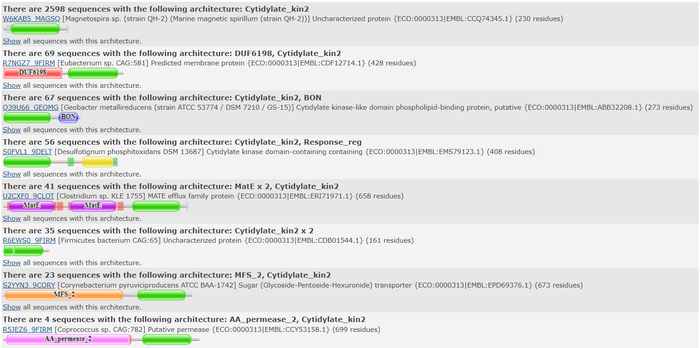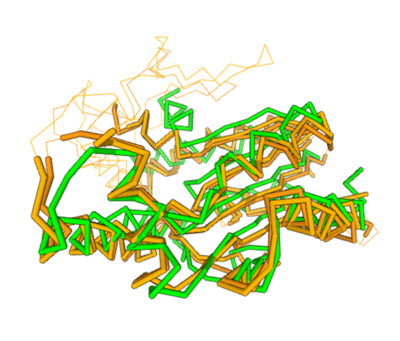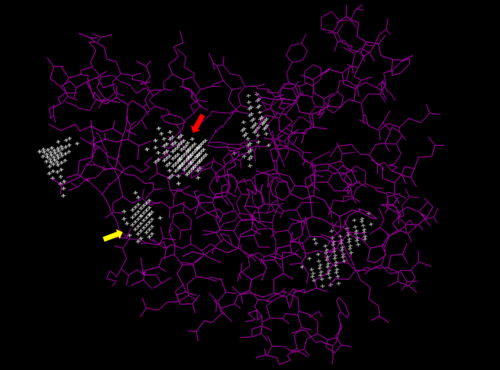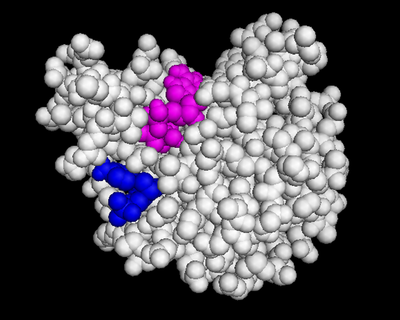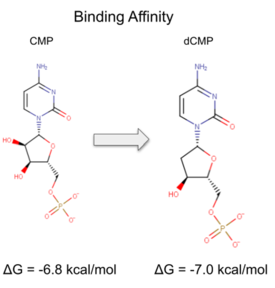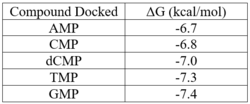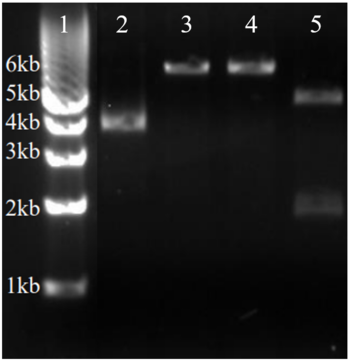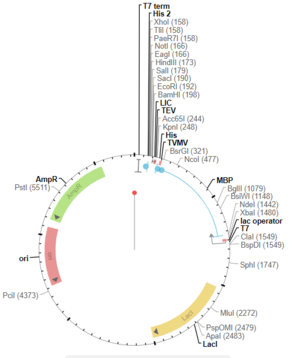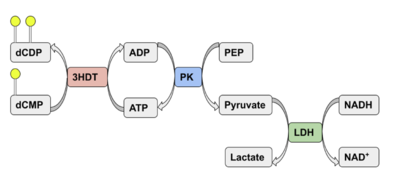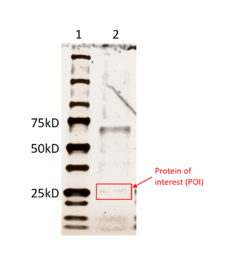BASIL2022GV3HDT
From Proteopedia
(Difference between revisions)
| (7 intermediate revisions not shown.) | |||
| Line 7: | Line 7: | ||
| - | == ''In | + | == ''In Silico'' Anaylsis == |
We used a variety of ''in silico'' tools to find similarities between 3HDT and other amino acid sequences, protein families, and 3-dimensional structures of known proteins in the PDB. Below are the recorded results and information from each database. From this information, a function was hypothesized for 3HDT and potential substrates such as dCMP were selected for kinase assays. | We used a variety of ''in silico'' tools to find similarities between 3HDT and other amino acid sequences, protein families, and 3-dimensional structures of known proteins in the PDB. Below are the recorded results and information from each database. From this information, a function was hypothesized for 3HDT and potential substrates such as dCMP were selected for kinase assays. | ||
| Line 95: | Line 95: | ||
| - | ===='''Coupled | + | ===='''Coupled Kinase Assay'''==== |
Two rounds of coupled kinase assays were run using 3HDT with ATP and dCMP as substrates. Various concentrations of dCMP between 5-10mM were used in a total of 8 assays. In the first round of assays (3 assays) 45.6ng of 3HDT and increasing concentrations of 5.0, 7.5, and 10.0mM of dCMP were added to wells each containing 100μL total. A concentration of 7.5mM dCMP resulted in the highest specific activity (0.377 U/mg) while increasing the substrate concentration to 10mM slightly lowered specific activity to 0.348 U/mg. When we repeated the first three kinase assays (5.0, 7.5, 10.0mM dCMP), there were discrepancies in the results indicating a potential experimental error such improper mixing, bubbles being present in the well, or too much time passing between adding substrate to the well and measuring absorbance in the plate reader. Additionally, the protein in the second round of assays was older (original protein but approximately a week had passed from time of over-expression) which could have affected the specific activity in those trials due to the protein starting to expire/decrease in function. | Two rounds of coupled kinase assays were run using 3HDT with ATP and dCMP as substrates. Various concentrations of dCMP between 5-10mM were used in a total of 8 assays. In the first round of assays (3 assays) 45.6ng of 3HDT and increasing concentrations of 5.0, 7.5, and 10.0mM of dCMP were added to wells each containing 100μL total. A concentration of 7.5mM dCMP resulted in the highest specific activity (0.377 U/mg) while increasing the substrate concentration to 10mM slightly lowered specific activity to 0.348 U/mg. When we repeated the first three kinase assays (5.0, 7.5, 10.0mM dCMP), there were discrepancies in the results indicating a potential experimental error such improper mixing, bubbles being present in the well, or too much time passing between adding substrate to the well and measuring absorbance in the plate reader. Additionally, the protein in the second round of assays was older (original protein but approximately a week had passed from time of over-expression) which could have affected the specific activity in those trials due to the protein starting to expire/decrease in function. | ||
| - | [[Image:Coupled assay.png |400px|left| thumb | Coupled kinase assay diagram with enzymes shown in color and phosphates in yellow | + | [[Image:Coupled assay.png |400px|left| thumb | Coupled kinase assay diagram with enzymes shown in color and phosphates in yellow.]] |
[[Image:Updated Kinetics Table 5.4.22 3.PNG |500px|center| thumb | Specific activity values and other data from all coupled kinase assays with 3HDT and dCMP.]] | [[Image:Updated Kinetics Table 5.4.22 3.PNG |500px|center| thumb | Specific activity values and other data from all coupled kinase assays with 3HDT and dCMP.]] | ||
| Line 105: | Line 105: | ||
| - | Background hydrolysis of NADH was measured and subtracted from the conversion rate in the presence of dCMP before calculating specific activity values. | + | Phosphorylation of dCMP is measured indirectly through the conversion of NADH to NAD+. Background hydrolysis of NADH was measured and subtracted from the conversion rate in the presence of dCMP before calculating specific activity values. |
===='''SDS-PAGE'''==== | ===='''SDS-PAGE'''==== | ||
| - | SDS-PAGE results for our purified protein sample are shown below. The first lane (left) contains a size standard and the second lane (right) contains our protein sample. The band in the second lane (right) at ~70kD is not the protein of interest (3HDT) but contains a metal binding protein. The mass of 3HDT is approximately 25.79 kD | + | SDS-PAGE results for our purified protein sample are shown below. The first lane (left) contains a size standard and the second lane (right) contains our protein sample. The band in the second lane (right) at ~70kD is not the protein of interest (3HDT) but contains a metal binding protein. The mass of 3HDT is approximately 25.79 kD which matches the faint band at ~26kD, indicating that our protein of interest was present. |
[[Image:3hdt sds page.png |225px| center | thumb | Results from SDS-PAGE with purified protein sample.]] | [[Image:3hdt sds page.png |225px| center | thumb | Results from SDS-PAGE with purified protein sample.]] | ||
| Line 115: | Line 115: | ||
| - | == Conclusion | + | == Conclusion & Future Experiments == |
| + | |||
| + | Our protein, 3HDT, was confirmed to be present using SDS-PAGE and showed activity during coupled kinase assays. While this confirms that 3HDT is a kinase, the true substrate is likely not dCMP due to the low specific activity values demonstrated in this work. Further research should be done with molecules such as TMP and GMP in the future to narrow down potential nucleotide substrates or elucidate other types of compounds to be considered as ligands for 3HDT. Additionally, in the future we would like to improve upon our protein purification process to try and get a higher protein concentration than what we achieved as the low concentration may have affected our coupled kinase assay results. | ||
| - | Our protein, 3HDT, was confirmed to be present using SDS-PAGE and showed activity during coupled kinase assays. While this confirms that 3HDT is a kinase, the true substrate was likely not dCMP due to the low specific activity values. Further research should be done with molecules such as TMP and GMP in the future to narrow down potential nucleotide substrates or elucidate other types of compounds to be considered as ligands for 3HDT. Additionally, in the future we would like to repeat the protein purification process to try and get a higher protein concentration than what we achieved as the low concentration may have affected our coupled kinase assay results. | ||
| - | </StructureSection> | ||
== References == | == References == | ||
<references/> | <references/> | ||
| + | [[Category: BASIL]] | ||
Current revision
Characterizing Putative Kinase 3HDT and its Potential Substrates
| |||||||||||
Proteopedia Page Contributors and Editors (what is this?)
Jesse D. Rothfus, Autumn Forrester, Bonnie Hall, Jaime Prilusky


